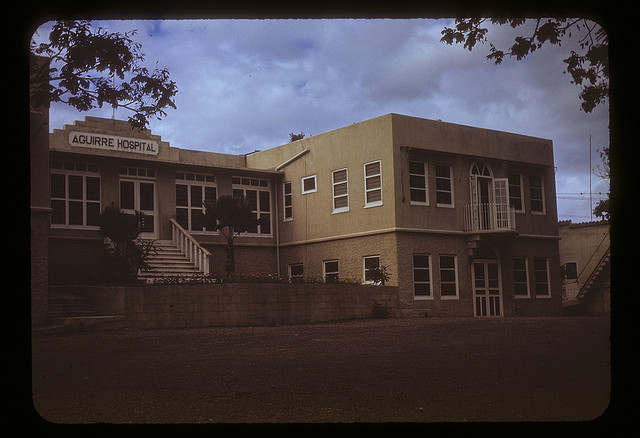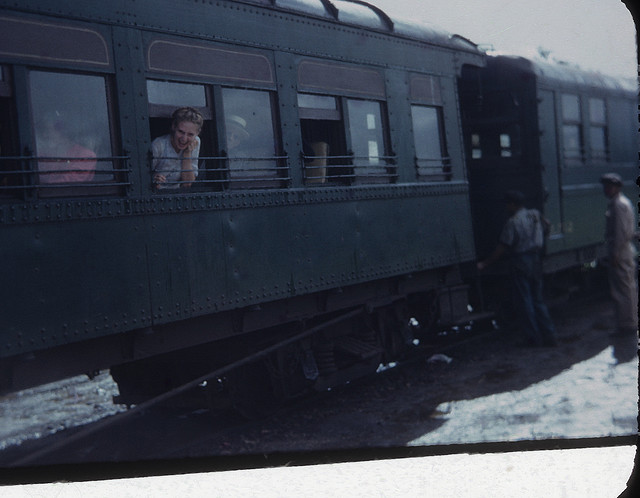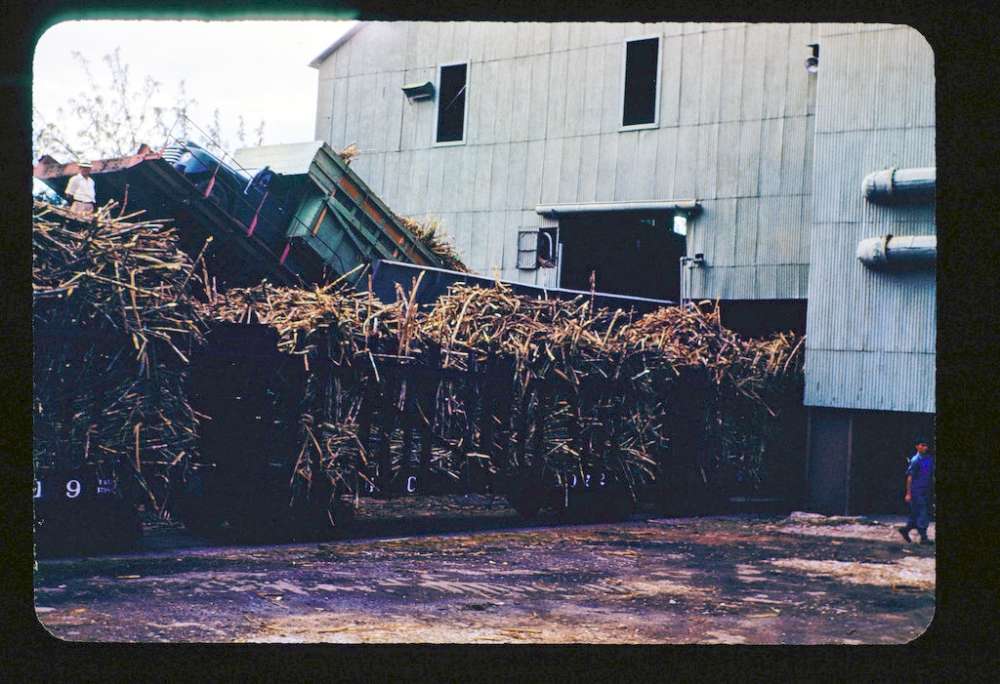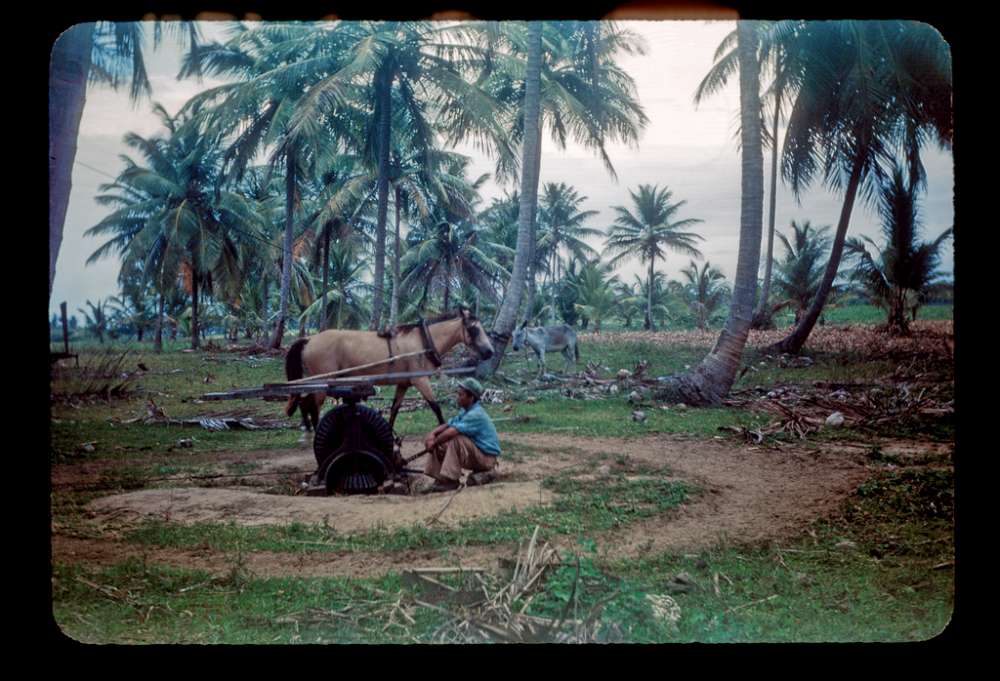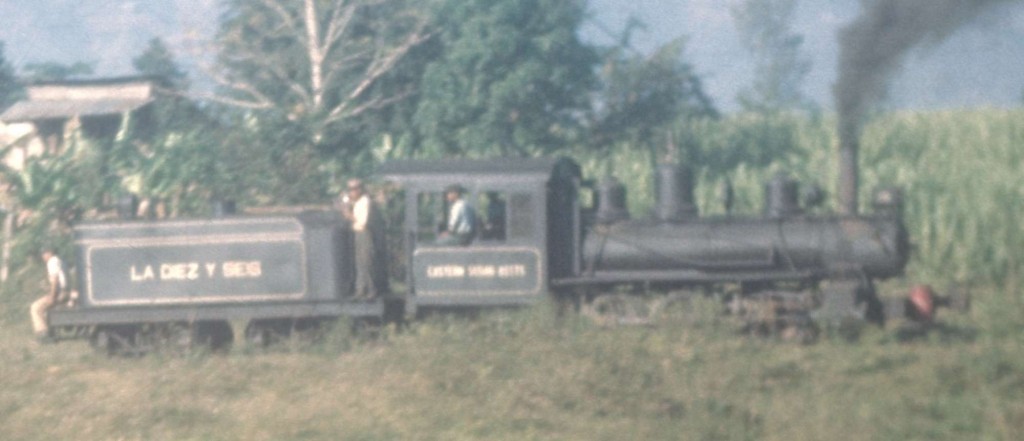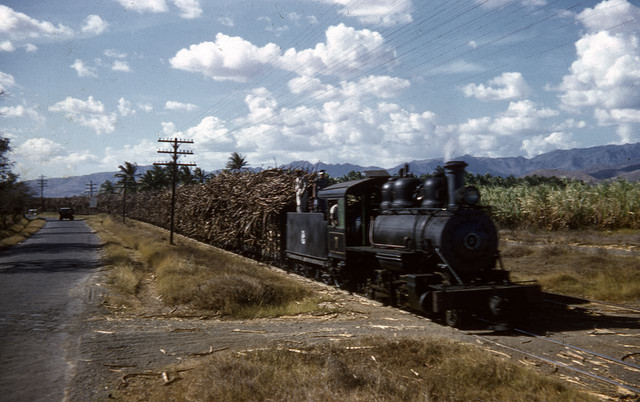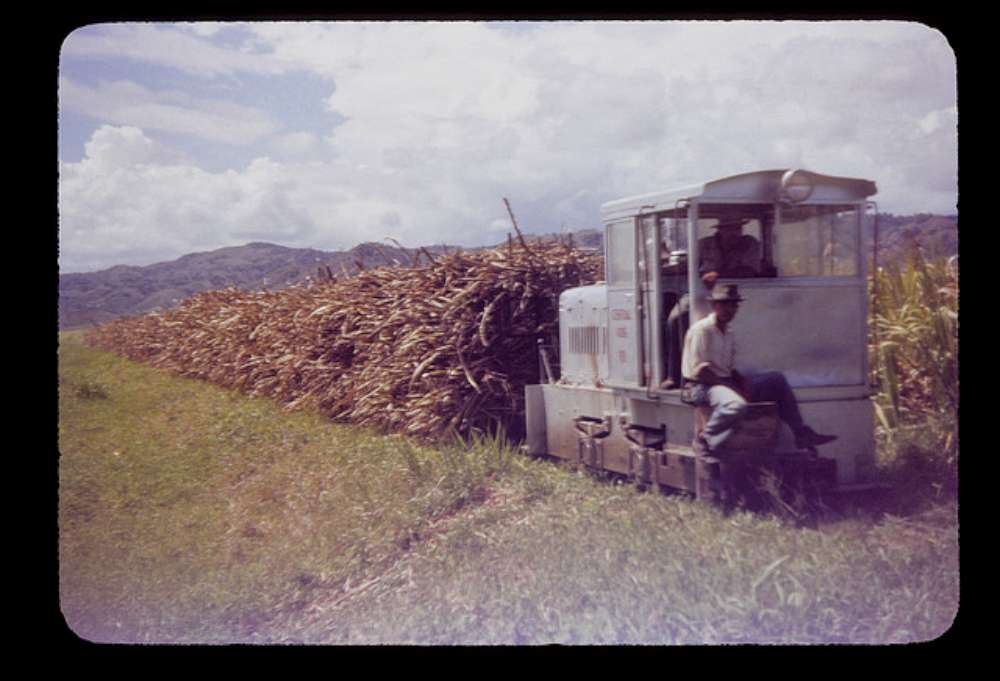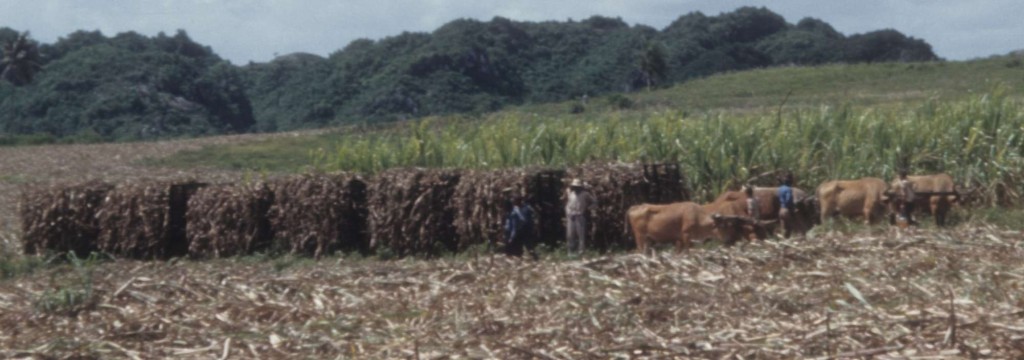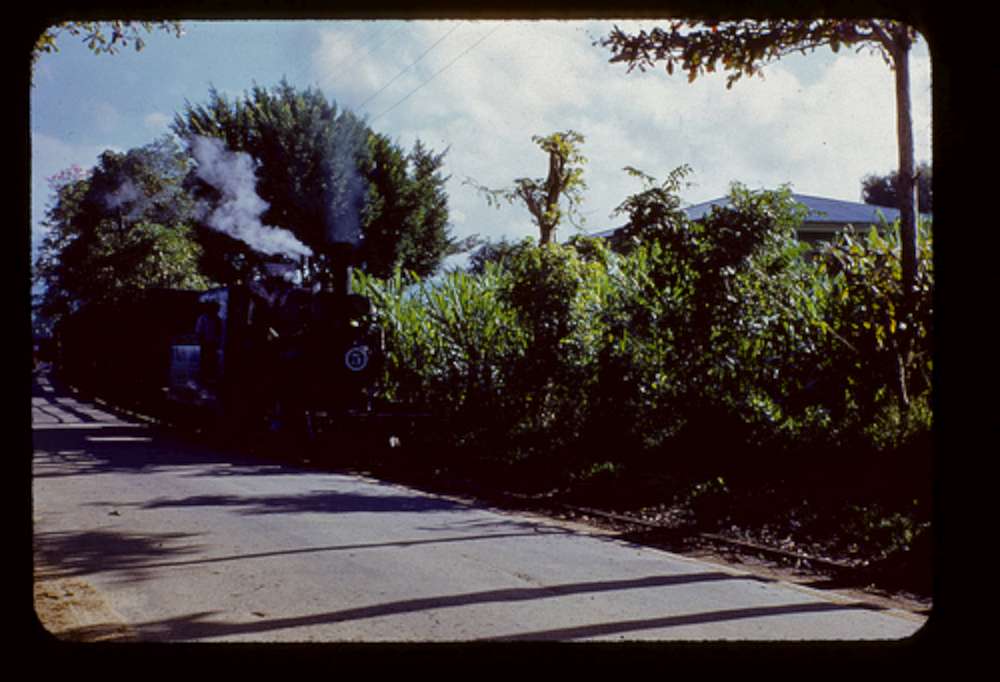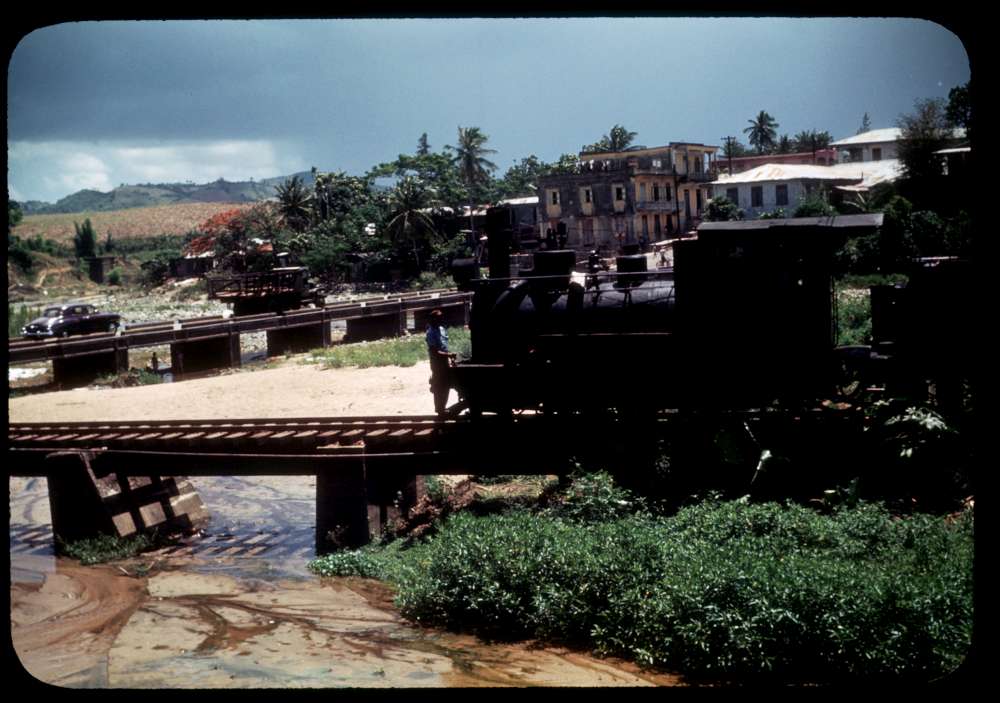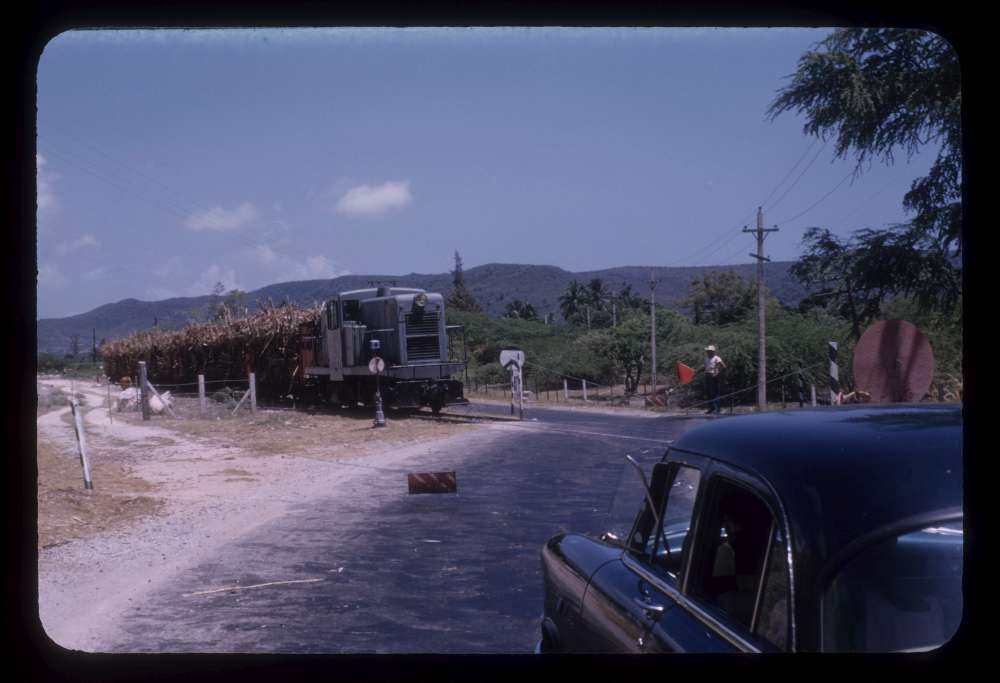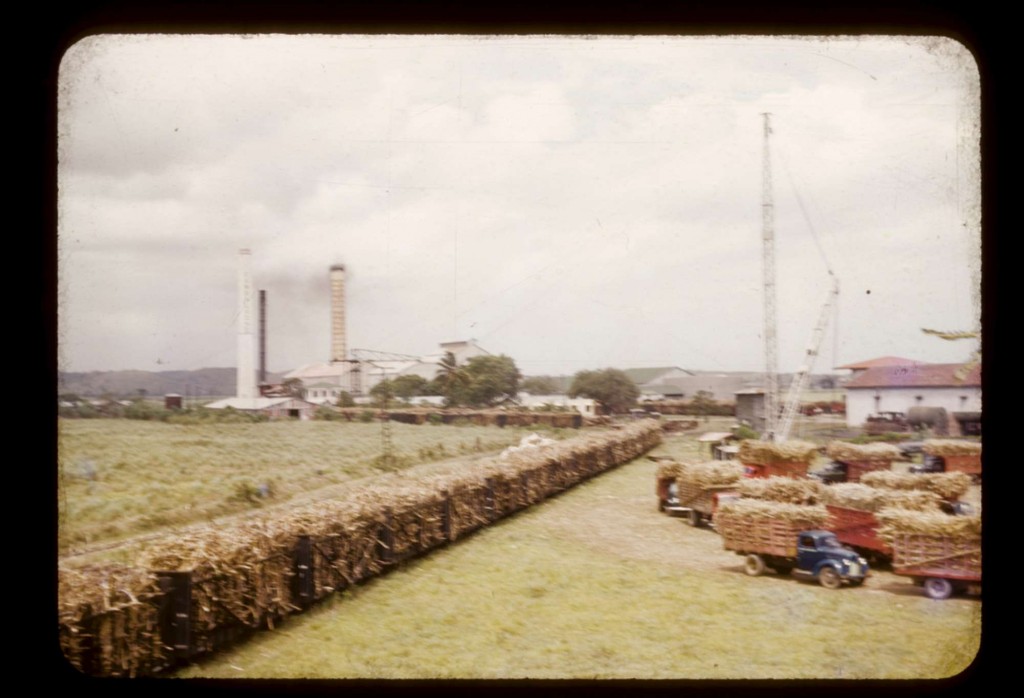Tom Lehman Photostream (Web Page)
Aguirre hospital – Puerto Rico, 1948-49. Roy and Glennys Henry.- #23,775
—
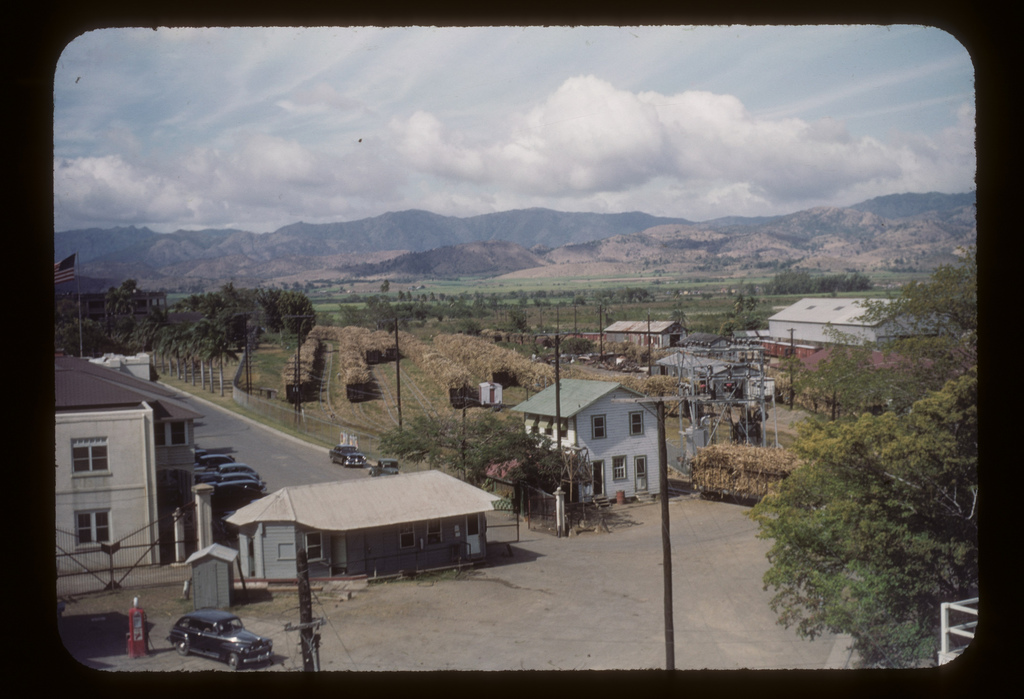
Aguirre Central – 1950. Fred Swartzendruber photo.- #21,538
—
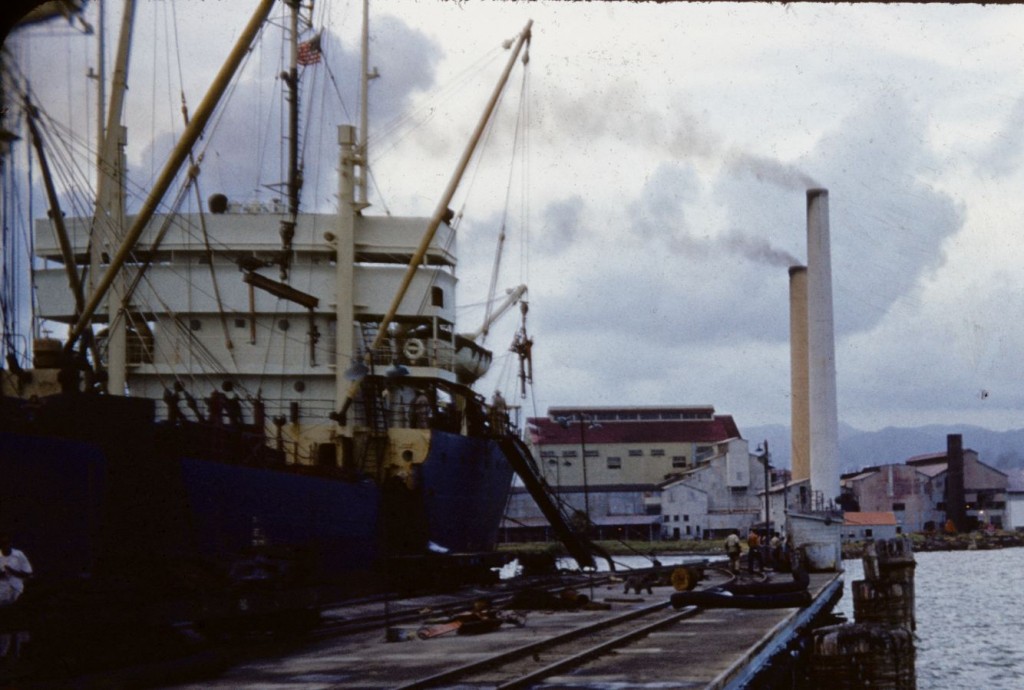
Ship at sugar central- Central Aguirre (see comments) – Between 1949 and 1952.
#11,836 – Dean Hochstetler photo
PR RR Historian:
This was the second arrangement of the Aguirre Sugar Co.’s
pier at Central Aguirre, where the railroad cars were moved out
onto the pier over the meter gauge tracks and unloaded into the
ships. At first, the harbor was too shallow and the sugar was
lightered out to anchored ships where it was again reloaded.
The last appearance of this pier had a large pipeline, through
which the sugar was conveyed to ships alongside it.
When the Government of Puerto Rico acquired this mill, Central
Machete, Central LaFayette and Central Mercedita (Oh, I forgot
Cortada) molasses and sugar were hauled by the Ponce &
Guayama to Central Mercedita for production of either sugar
at the mill from the raw sugar, or rum from the molasses at
the Distilleria Serralles (Don Q). The pier was still there in
1982, the last time I visited the mill site. I have over five hundred
photos of the P&G, Machete and Mercedita railroads operating,
including several of Plymouth locomotives and sugar cars out on
the pier.
—

Railroad station on trip around the island – Yauco (see comment). Between Aug. 1950-May 1952. – Orris Yoder photo – #9,890
Woman looking out the window of a train – Between Nov. 1945-Nov. 1948
#3299 – Paul Leatherman photo
PR RR Historian:
The most interesting object in this picture is actually the car that
we see behind the coach with the passenger looking out.
The American Railroad bought five Baldwin steam cars in two
separate deliveries, designed to run on low traffic parts of the
railroad. One set of two ran between San Juan and Arecibo.
Another single one ran from San German to Sabana Grande.
Because they could pull one or two cars, the one to Sabana
Grande earned the nickname “Tren Batata” because it often
hauled a car or two of bananas, plantains, sweet potatoes
or other “frutas menores” behind the steam car.
The steam car was basically a large, heavily constructed
combination coach and baggage/mail car. On the rear it
had a standard coach truck. However the front was actually
nothing more than a small steam locomotive inside the
baggage car end of the body. The bodies were built by
Wason Car Co. and Baldwin built the guts to power it.
When traffic dropped on all the short runs, these steam cars
were converted one by one to luxury first class cars. The end
where the engineer sat is what we see here. There are actually
more pictures of these cars than of the steam cars themselves.
Another name for the steam cars was “motores”. All five
served until the last passenger trains ran under the Puerto
Rico Railroad & Transport. They were scrapped by 1955.
Unloading sugar cane at the mill – #463 – Luke Birky photo
pr rr historian1:
This action is at Guanica Centrale. The mill railroad cars were lettered with a simple
GC seen on the left side of the cane car, and the car number appears to the right side.
Guanica Centrale’s cane cars had two compartments, with wooden stakes reinforced by
diagonal angle iron struts across the face of each section.
—
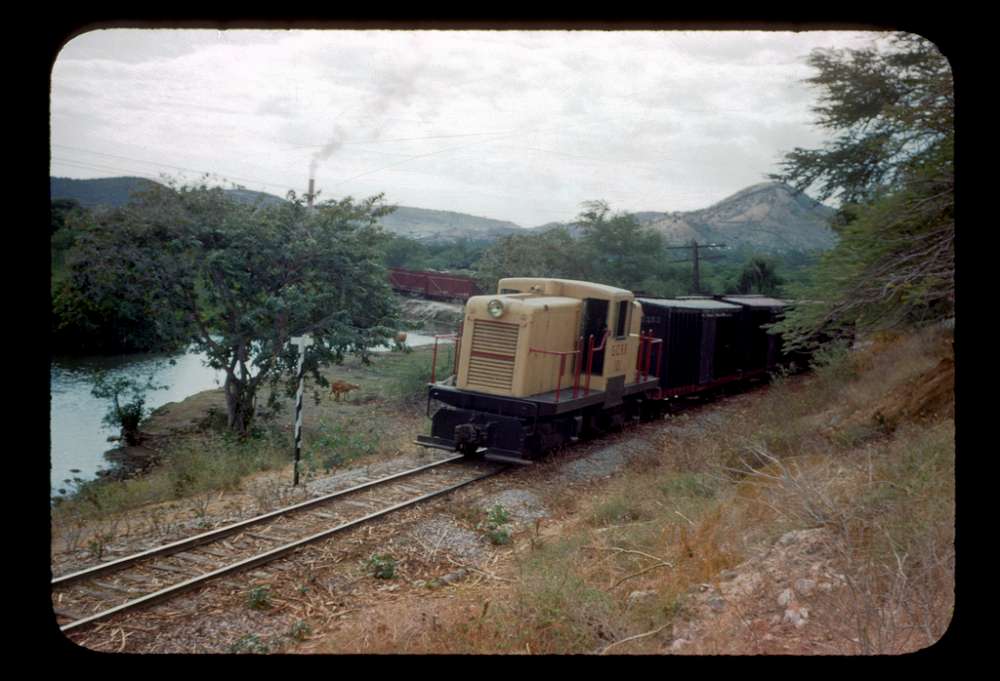
Narrow gauge train – Feb. 1949
#993 – Robert Ebey photo
PR RR Historian:
Almost right, Rick. This is a General Electric product, not Davenport. The mill owned two of these locomotives, 47 ton, split frame, two
trucked, diesel-electric locomotives identical to those owned in the last years by the American Railroad. They pretty much replaced the
last few steam locomotives Guanica Centrale railroad, assisted by
several smaller diesel-mechanical locomotives, as the decline
of sugar cane grown and harvested necessitated fewer trains,
fewer cars and fewer locomotives. When the coastal railroad
under the ownership of employees, formerly called the American
Railroad and later called the Puerto Rico Railroad & Transport
Co., was abandoned after years of bankruptcy and reorganization,
the mill (and so many other mills) lost the connection to San Juan
and Ponce and the many colonos along the PRR&TCo. that shipped
their cane via the railroad. The end of the PRR&TCo. spelled the
end of many of Puerto Rico’s mill railways and changed the sugar
economy of Puerto Rico quite drastically. In the picture, the
locomotive is pulling what appears to be covered hopper cars
used to transport sugars, probably to or from the connection at
Santa Rita. The location of the stream on a map of the railroads
would tell us which way the train is going, so I will have to dig out
my USGS maps to see the direction of travel.
—
Cane mill, horse harnessed to winch, driver resting
The Piñones- Vaciatalega area, not far from San Juan (identified by j_pons)
Between 1944 and 1947. – #2396 – H. Clair Amstutz photo
—
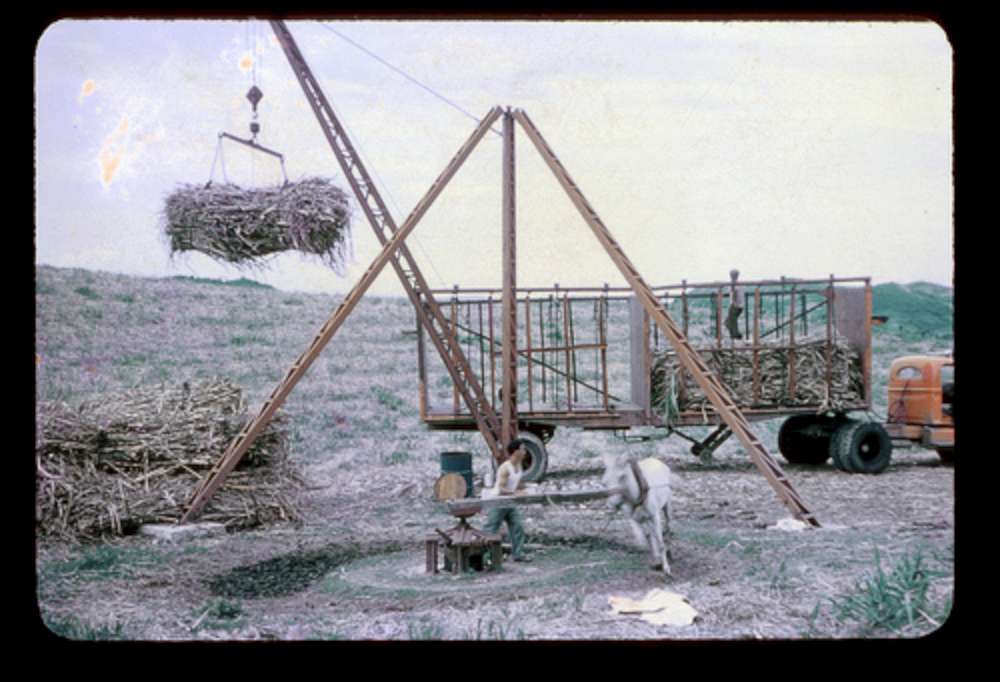
Donkey winching up sugarcane to load on truck – #1467
Ron Collins photo – Appears to be a copy of #1136
—
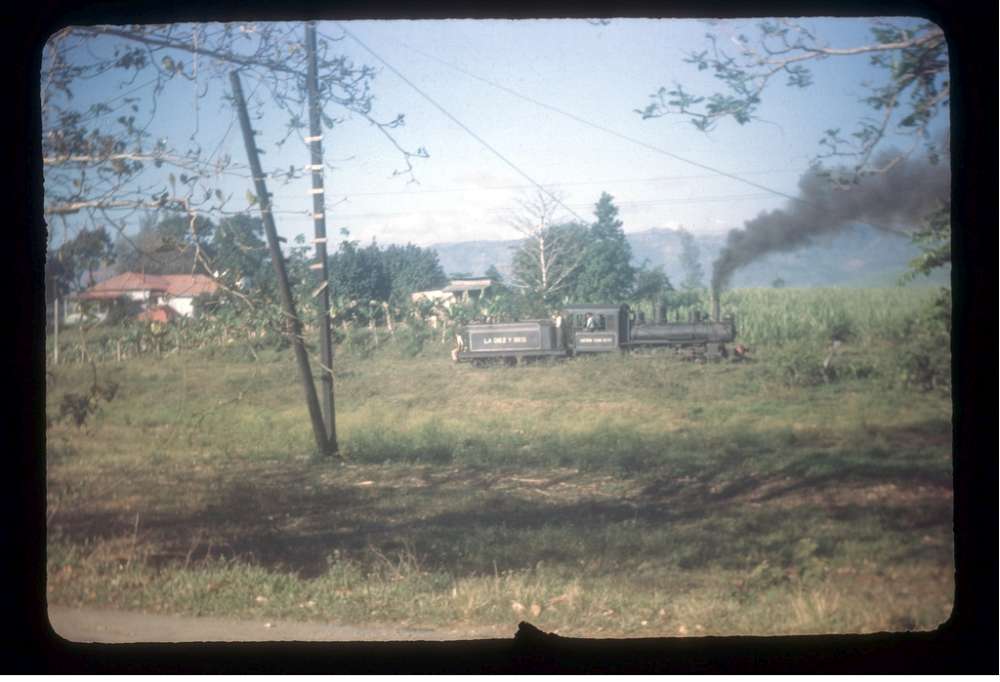
La Diez y Seis train – Puerto Rico, 1943-46
Delbert Preheim photo. – #28,848
pr rr historian1:
The locomotive is Eastern Sugar Associates Porter 2-6-0 #16, purchased from the
Ferrocarril de Humacao which served Central El Ejemplo in Humacao. It was 30″
gauge until converted in 1930 to work the ESA mainline from Caguas to Playa Humacao.
By the pitch of the tender behind the locomotive, it must be working a branchline that
has lost some of its leveling, causing dips and rises in the trackwork seen here in the
positioning of the two parts of #16. This old girl dates to 1910, and exemplifies the
longevity of a well-maintained and operated steam locomotive. This photo was probably
taken on the eastern end of the railroad, not far from Central Juncos. But that is just a
guess based on the size and distance of the mountain range in the background. It looks
like the Pena Pobre area to me.
Steam locomotive pulling sugarcane – #11,126. – Addona Nissley photo
PR RR Historian:
And the correct answer is: Ponce & Guayama Baldwin 2-8-0 #7,
built 11/1917, serial #47234, 35 1/2 tons in weight with full
compliment of fuel & water, rebuilt 1929 with a new boiler from
Baldwin on Extra Order #1100. A photo published in El Mundo
in the early 1960s shows the locomotive in service crossing a
bridge over a stream with several naked youngsters playing in
a pool beneath the structure. I found #7 and sisters #8 & #13
(Ex-Los Canos #1) still intact minus side rods at Central
Aguirre in 1967 and photographed them. In 1971 Jorge Wirshing
purchased all three for scrap value to display at his Ferrocarril
Historico in Fajardo. I was on hand when the truck delivered
each one. In the photo, the train is headed to Central Aguirre with
a long string of Gregg side-emptying 20 ton cane cars. Many of
these were rebuilt and received sheet metal sides and an extension
at the top angled outward to increase capacity and facilitate the
loading of chopped cane from several new loading facilities at
Arroyo and east of Santa Isabel. Gauge is one meter, the
principal gauge of Puerto Rico’s main railroads. The locomotive
was cut up for scrap after a flood destroyed the Fajardo park.
The influx of internal combustion locomotives began in 1934, so
the old girl did work side-by-side with a large fleet of all-new
Plymouth diesel mechanical and hydraulic units and a few odd
purchases both new and secondhand.
If one examines the photo carefully, you’ll see the locked P&G
initials which the steam locomotives sported for many years.
I won’t commit on the location, but it appears to be a spot just
west of the series of crossovers and switches where the lead
tracks to the mill leave the east/west mainline. Remember the
sun passes from the east end of PR and stays quite high through
the tropical sky during the period of the zafra (harvest) and if you
stay on the south side of the track as you followed the trains you
always had the sun on the sides of the trains (with only a few
exceptions where track turned northward or southward briefly).
It then would actually allow this train to be going in either direction.
I hope somebody can legitimately locate the position of this train,
given the changes in the terrain over the years since this photo
was shot.
—
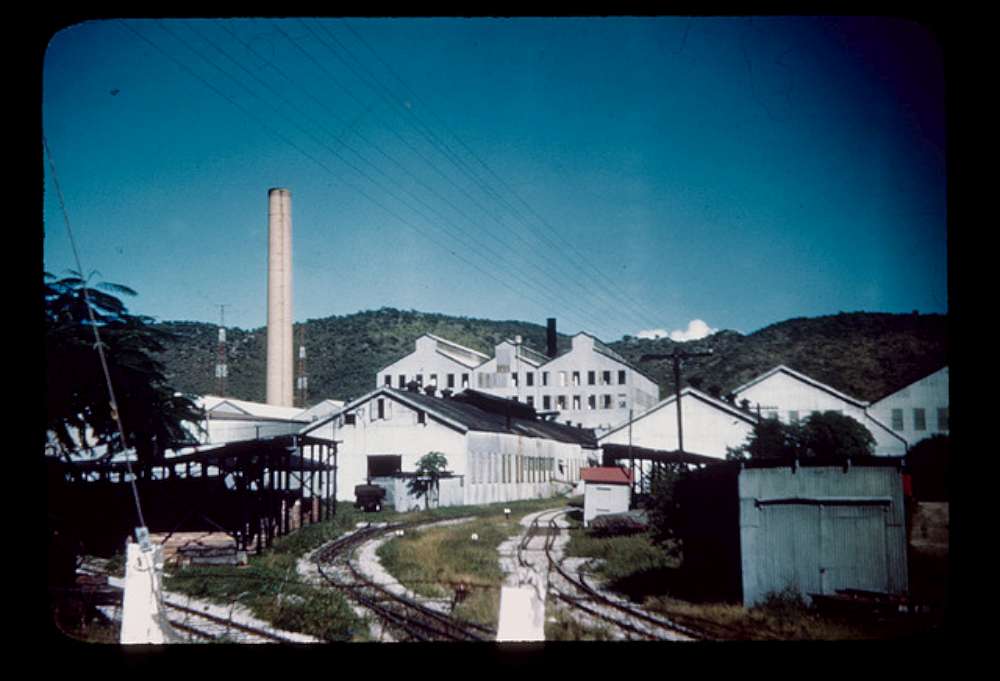
Coastal sugar mill- Between 1943-46; 1948-52.
#2595 – Justus Holsinger photo
PR RR Historian:
Yes, it is Guanica Centrale of the South Porto Rico Sugar Co.. We
are looking at the right side of the main railroad’s cane storage
yard. In another photo posted by the Rodriguez’ brothers, I commented on the small white building and how a scale to weigh
railroad cars operated. This photo best shows the two sets of
tracks needed for the car scale, which is probably a product of
Fairbanks. Only one gauged set of rails actually crosses the
scale table. A second set of rails also gauged are somewhat
offset and are supported by concrete feet not connected to the
table. Only the cars would pass over the scale rails, while the
locomotive would be restricted from it to prevent damage from
its tractive effort of the wheels and its gross weight probably
exceeding the measurement capability of the scale. Hence, the
locomotive would first bypass the scale tracks, and after the last
loaded car passes the switch, it would then begin to back the cars
slowly over the scale, stopping when both trucks of the car were
on the scale so the gross weight could be determined. From
that the weight of the average sugar cane car by class would be
deducted to find the actual weight of the cane in the car. This
was one factor in determining payment to a colono. The other
would be the juice content and sugar level, done by a boring into
the car to be analyzed by the mill’s laboratory staff. Once both
factors are considered, payment for that particular car of cane
would be calculated.
Without a map in front of me, I couldn’t calculate which way is
which. I do know that the bay at Ensenada would be to the left
and on behind us. Behind the mils buildings, to the far left is
a large “mountain” atop which was the manager’s more sumptuous
dwelling. The track would curve around that hill and go to the
harbor docks and molasses storage tanks near them. The
facility handled quite a bit of traffic at its height and demanded that
the Porter locomotive #1 be there almost constantly working the
tracks moving cars. Not only were there outgoing shipments of
sugars and molasses, but incoming supplies. Then there was
the cane brought from the Dominican Republic via barges moved
by tugboats. The arriving cane had to be fumigated to prevent the
introduction of any diseases or pests, and then stored for a short
period of time before being weighed and ground back at the mill.
This process also occurred at Playa Humacao, when the United Porto Rico Sugar Co. purchased Centrales Defensa, Santa Juana,
Cayey, Juncos, Pasto Viejo and Puerto Real, the latter being on
Vieques. The Puerto Real mill was closed, but sugar was still
grown in the lands formerly owned by the mill. The railroad
remained intact and transported the cane in cars to a dock near
the mill, where it was loaded into barges. The United Porto Rico Sugar Co. owned a small fleet of tugboats under a different name
and these moved the loaded and empty barges between Vieques
and Playa Humacao. Because the cane from one part of Puerto
Rico to another, there was no fumigation required.
Something of interest is the fact that the Government of Puerto Rico
put a sizeable tariff on the Dominican cane. In the 1930s they
increased the tariff dramatically, and while the SPRSCo. fought
this in court, they ceased the operation of barging cane to Guanica.
When the tariff was reduced, they reinstituted it for a few years until
once again the government raised the tariff and it was no longer
feasible to continue the barging. I believe it was 1939 when the
barging ended, but I do not have the court papers and annual
reports in front of me right now.
Narrow gauge train with load of sugarcane – Yabucoa Valley (see comment). 1940s.
#1987 – Carl Epp photo
PR RR Historian [deleted] (40 months ago)
Correct on the location and the owner. This little critter is part of
a fleet of 26″ gauge diesel-mechanical locomotives owned by the Yabucoa Sugar Co.’s Central Roig mill. The mill underwent several earlier names before being purchased by Don Antonio Roig. It was
originally Ingenio Yabucoa, then Central Mercedita (not to be
confused with Don Juan Serralles’ Central Mercedita east of
Ponce). The roster of internal combustion locomotives was comprised mostly of these Whitcombs, but did include one
Plymouth and one German locomotive built by Gmeinder. For
quite a few years after the railroad was dismantled, the fleet
of lokies were housed inside their enginehouse, filthy and
surrounded by all sorts of debris. I was able to get into the
building and photograph all of them not long before the whole
lot was scrapped.
Ironically, the other Mercedita was also 26″ gauge and also
owned a wonderful variety of tiney steam and diesel-mechanical
locomotives before converting every part of the railroad to meter
gauge and buying heavier locomotives.
—

Oxen pulling cars of cane near Vega Baja – Puerto Rico, July 18, 1948
Chester Peckover photo. #28,443
—
No 5 train next to road bed – 1950s
#325 – Luke Birky photo
pr rr historian1 (29 months ago)
The locomotive seen here is Eastern Sugar Associates Porter 2-6-0 #5. The location
looks like a stretch of track alongside the road from Juncos to Naguabo, at Pena Pobre.
No. 5 was purchased by the original owners of Central Juncos. It later became United
Porto Rican Sugar Co. # 5, and then went to ESA. By the time of this photo, only two
Porter locomotives of seven had survived on the ESA roster, and by the merger which
formed Fajardo-Eastern Sugar Associates, this locomotive had been scrapped and replaced by diesel-mechanical units. Porter locomotives were the product of H. K. Porter
of Pittsburgh, Pennsylvania, and were a leader in small industrial and plantation steam
locomotives.
—
Train at Fajardo, near Luquillo – See comment for location specifics. Between 1948 and 1950. – #3999 – Robert Ebey photo
PR RR Historian:
In this photo, the locomotive is the key ingredient in identifying the
railroad and approximate location. There were only two locomotives
like this one, bought by the original French owners of Central Santa
Juana (Cie. Sucrerie Ste. Jean originally) from Belgian builder
THIRAU. Originally shipped as tank locomotives that appeared
like beetles.they were henceforth named accordingly by native workers as such in Spanish. They had six drive wheels. The mill
was purchased by the United Porto Rico Sugar Co. in 1928, and
then again by Eastern Sugar Associates in 1932. This mill was
meter gauge, while all of the other railroads headed East toward
Humacao via Juncos were 30″ gauge. Under the expertise of
Don Domingo Cruz of Central Pasto Viejo, all the locomotives of
Central Juncos and Pasto Viejo mills were converted to meter
gauge at Pasto Viejo, in 1929 under UPRSCo., and so was the
track from Pasto Viejo westward. A connection between the
terminus of the Juncos track near Gurabo had to be built at this
new gauge to connect Santa Juana and Juncos to complete the
system.
Santa Juana used these two locomotives originally to climb a steep
grade between the mill on the northeast corner of Caguas, to
San Lorenzo.
When rebuilt, these locomotives were modified, the coal bunker on the rear of the cab was removed, and an eight-wheeled coal tender
was added for fuel. The water tanks on the locomotives were also
removed, as the tender contained a water tank arrears of the coal
bin. I am not sure of the location of this photo, but I highly suspect
that it reflects a wet area along the Rio Grande de Loiza close to
the mill and the city of Caguas, and well may be the point where
the line to San Lorenzo departed the line eastward to Turabo and
Juncos. For a brief few years in history, the Santa Juana mill’s
main connection to the outside world was via the Caguas Tramway
Railroad that went from Rio Piedras to Caguas via Trujillo Alto.
Old freight bills from the later owner of the Caguas Tramway show
several billings for cars of fertilizer and other supplies for Santa
Juana, which were interchanged near the mill. A small amount of
cane came off this line too from colonos along the line from
Trujillo Alto to the interchange, although most billings from the
second owner (Porto Rico Railway Light & Transit Co. – Canadian)
were for Central Defensa or Central Vannina (near Guaynabo)
(Later under new ownership called Central San Jose). The
PRRL&PCo. railroad was abandoned in 1928, ending that
connection just before the mill became the property of the PRSCo..
For a number of years, Santa Juana’s two Thirau locomotives
ventured as far as Central Juncos. The mill itself enjoyed connection
with a large system which ran from Caguas to Playa Humacao, and
where not too distant west of there was a connection with the Fajardo
Development Co. RR as far west along the north coast to Carolina,
where it then connected with the American Railroad’s branch and
gave the mill access to San Juan harbor too.
One Thirau survived into ownership by Fajardo-Eastern Sugar
Associates as a stationary boiler at Playa Fajardo’s pier and
storage facilities after doing switching chores there to load and
unload ships by railcar, and to also receive sugar cane from
Vieques by barge which was transferred from the barge to awaiting
cane cars.
Jorge Wirshing, founder and owner of the defunct Ferrocarril
Historico, remembers the two Thirau’s as having an unusual
“hiss” to their exhaust unlike the other American-made locomotives
under Eastern Sugar Associates ownership. Crew members I
interviewed in the 1960s said these were the most powerful of
all the European steam locomotives to have worked in PR, a
fact Don Domingo Cruz firmly justified. He also noted that aside
from the smaller “tires” on the drive wheels, most parts were very
easy to duplicate without the necessity of employing outside firms
like Sucesores Abarca in Miramar, making repairs less costly.
—
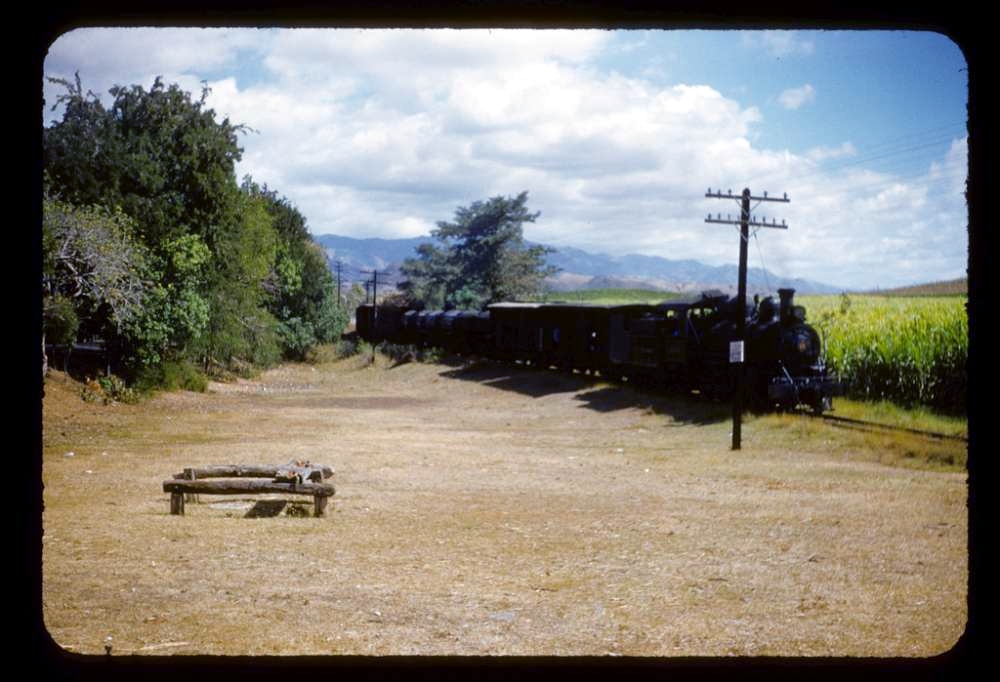
Freight train – Between Aug. 1950-May 1952.
Orris Yoder photo – #9,893
PR RR Historian:
This is an American Railroad Co. freight train pulled by one of their
last batch of American Locomotive Co. (ALCO) 2-8-0s, and when
magnified, the number plate seems to indicate she is #89. The
tank cars between the short strings of boxcars, could either be
filled with molasses or fuel oil, the oil going to fuel locomotives or
other equipment at sugar mills. It is difficult to say where this is,
as there are no landmarks to be found.
—
Sugarcane train
Puerto Rico, between 1952-55. Bill and Thelma Swartzendruber photo.
pr rr historian1:
Great shot… This is one of two General Electric 47 ton diesel-electric locomotives
owned by Guanica Central. When enlarged, the initials GCRR are legible, but
the number is not. It would be either #101 or #102. Noteworthy is the different
color of the locomotive in this picture compared to the yellow scheme in another
photo you have in your photostream. I am glad this slide was discovered and shared,
as it is one of the very few photos I have seen to date of Guanica Centrale trains in
operation.
t13hman (22 months ago)
I enlarged the original uncompressed tif file, and it’s almost certainly number 102.
pr rr historian1 (21 months ago)
Right up until the last years of the P&G and Central Mercedita moving the cane by railcar,
the kids still did the same. Some even hitched rides on the train cars, and the crews
never seemed to bother chasing them away. I have movies I took of both kids hitching
rides and of kids pulling the stalks of cane that protruded from the cars and with their
pocket knives shaving the outside off of the cane. Sadly, one time when I was taking
photos near Gurabo on the Juncos railway, a young boy hitched a ride on the last
car of a long train of sugar cane headed back toward Juncos. As the cars crossed a
quite long and high trestle over the river, the young fellow lost his grip and fell, hitting his
head on the rail and falling about twenty five feet to the rocky river below. Between the
severe blow to his head and more trauma to his body on the rocks below, he died
shortly after arriving at the hospital in Caguas. I had to drive to a crossing ahead of
the train and get it to stop to tell them what happened, while another spectator went
down with some of his friends to try to rescue him. That was not such a great day
for me, as I couldn’t do any more photography. A very rude awakening to the fact
that railways can be very, very dangerous place to play.
—
Sugar cane train – Cambalache sugar mill,
Arecibo. 1950s – #206 – John Driver photo
—
#2594 – Justus Holsinger photo
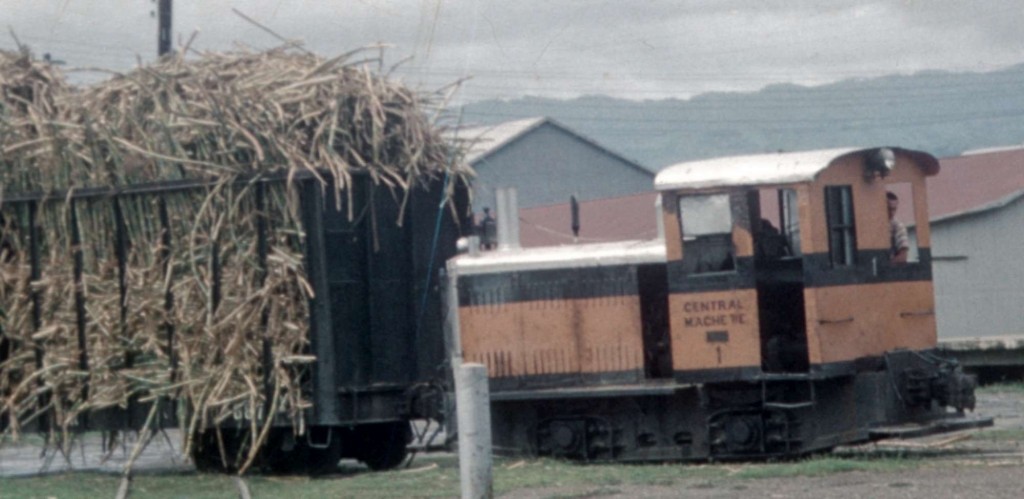 pr rr historian1:This is definitely Central Machete, and locomotive #1 is a 12 ton Plymouth diesel-mechanical unit. Central Machete was originally an independent mill south of Guayama.
pr rr historian1:This is definitely Central Machete, and locomotive #1 is a 12 ton Plymouth diesel-mechanical unit. Central Machete was originally an independent mill south of Guayama.In the 1930s, it became a wholly-owned entity of the Aguirre Sugar Co.. This locomotive
was purchased to replace aging steam locomotives #1-4. Until the new ownership, the
mill had a 30″ gauge railway. This was converted to meter gauge by Aguirre Sugar. The
Ponce & Guayama RR had already reached Machete under the original ownership, for
transport of the mill’s sugar and molasses. Machete was torn down in the late 1960s,
and only the enginehouse and several smaller buildings remained standing.
No. 1 appears in the original paint worn by Machete diesels. A second diesel was added
to the mill’s roster by Aguirre Sugar, and the last steam locomotives were scrapped. About
1948, a third, used diesel was added to the roster. In 1970, the three locomotives were transferred to Central Aguirre, and they were repainted in the familiar P&GRR red scheme, still bearing #1, 2 and #3.
The locomotive in the picture and its sister Plymouth #2 would live on, going to two different railroad theme parks in Bayamon.
When cane was still being grown in Puerto Rico, there were many vendors selling the cane
juice, guarapo de cana, freshly pressed from the cane stalks with small mechanically driven
trapiches. You had to be careful though, and request only a fresh bottle of juice made while
you watched, as some “cheaters” would water it down. The guarapo was always the best drink you could get from one of these roadside vendors. As close as you can get anymore,
is a piragua made with melao!
When Cortada was shutdown, there were still several loading stations for sugar cane both
at the millsite and on several of the original lines that belonged to the Cortada railway. P&G
cane cars were used, and up until 1970, the three small locomotives I mentioned served those
loading stations, assembling the loaded cars on several sidings at the mill yard, for P&G
locomotives to pick up to take to Aguirre. On my photostream are several pictures portraying
this activity.
—
See / Ver: Tom Lehman Photostream (Web Page)

